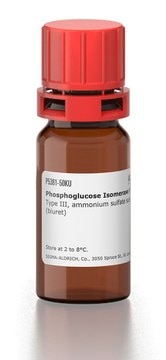F2668
Phosphoglucose Isomerase from baker′s yeast (S. cerevisiae)
for use with Fructose Assay Kit FA-20
Synonym(s):
D-Glucose-6-phosphate ketol-isomerase, PGI, Phosphosaccharomutase
Sign Into View Organizational & Contract Pricing
All Photos(1)
About This Item
Recommended Products
Quality Level
analyte chemical class(es)
sugars (fructose)
technique(s)
photometry: suitable
application(s)
food and beverages
general analytical
storage temp.
2-8°C
Looking for similar products? Visit Product Comparison Guide
related product
Product No.
Description
Pricing
Signal Word
Danger
Hazard Statements
Precautionary Statements
Hazard Classifications
Resp. Sens. 1
Storage Class Code
11 - Combustible Solids
WGK
WGK 3
Flash Point(F)
Not applicable
Flash Point(C)
Not applicable
Personal Protective Equipment
dust mask type N95 (US), Eyeshields, Gloves
Choose from one of the most recent versions:
Certificates of Analysis (COA)
Lot/Batch Number
Sorry, we don't have COAs for this product available online at this time.
If you need assistance, please contact Customer Support.
Already Own This Product?
Find documentation for the products that you have recently purchased in the Document Library.
Customers Also Viewed
Kosei Nakajima et al.
Oncology reports, 28(6), 1953-1958 (2012-10-03)
Autocrine motility factor (AMF) plays an important role in the development of metastasis by regulating tumor cell motility. The expression of AMF is associated with metastasis in malignant musculoskeletal tumors including osteosarcoma. Recent studies indicated that hyperthermia contributes to the
Veera Kainulainen et al.
Journal of bacteriology, 194(10), 2509-2519 (2012-03-06)
Glutamine synthetase (GS) and glucose-6-phosphate isomerase (GPI) were identified as novel adhesive moonlighting proteins of Lactobacillus crispatus ST1. Both proteins were bound onto the bacterial surface at acidic pHs, whereas a suspension of the cells to pH 8 caused their
Simone Frédérique Brenière et al.
PLoS neglected tropical diseases, 6(5), e1650-e1650 (2012-06-12)
The current persistence of Triatoma infestans (one of the main vectors of Chagas disease) in some domestic areas could be related to re-colonization by wild populations which are increasingly reported. However, the infection rate and the genetic characterization of the
Esdenka Perez et al.
Infection, genetics and evolution : journal of molecular epidemiology and evolutionary genetics in infectious diseases, 13, 116-123 (2012-10-11)
In the Gran Chaco region the reinfestation by Triatoma infestans remains a major problem for control of Chagas disease. Trypanosoma cruzi the agent of the illness presents a broad genetic intraspecific variability which is poorly documented in the Bolivian Gran
Monica Totir et al.
PloS one, 7(2), e32498-e32498 (2012-03-07)
Structural biology and structural genomics projects routinely rely on recombinantly expressed proteins, but many proteins and complexes are difficult to obtain by this approach. We investigated native source proteins for high-throughput protein crystallography applications. The Escherichia coli proteome was fractionated
Our team of scientists has experience in all areas of research including Life Science, Material Science, Chemical Synthesis, Chromatography, Analytical and many others.
Contact Technical Service




